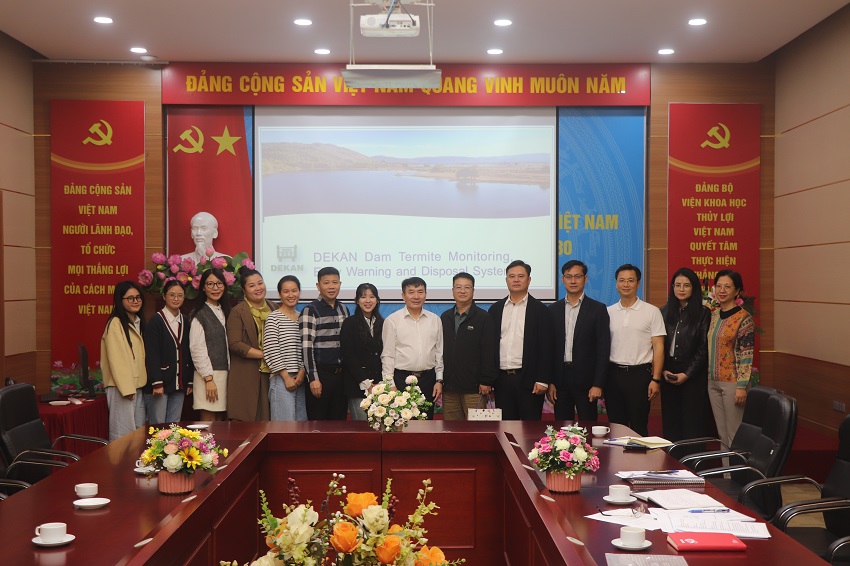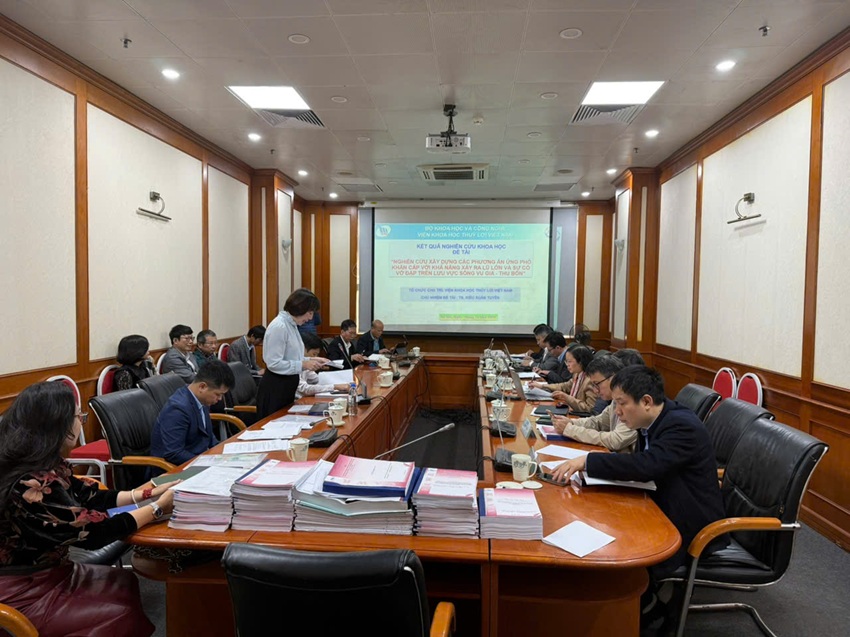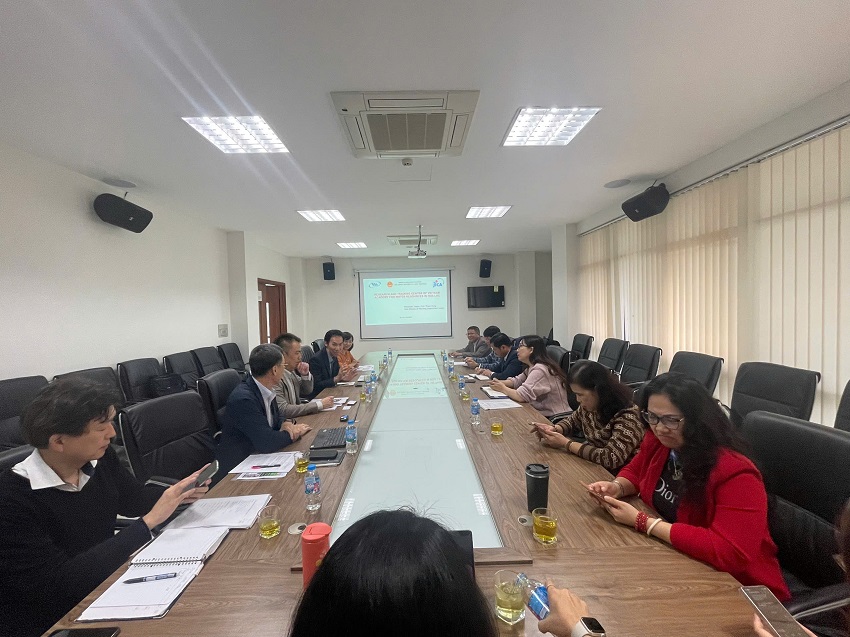Improved flood depth estimation with SAR image, digital elevation model, and machine learning schemes
15/04/2024A B S T R A C T
Study region: Nhat Le river basin, the floodplains of Central coast of Vietnam. Study focus: Flood disasters have a significant impact on population and economies worldwide. To accurately assess flood damage, it is crucial to estimate the water depth and predict the potential spread of damage. However, conventional methods of estimating flood depth can be time-consuming and costly due to the large amount of data required from hydraulic and rain-runoff models. To overcome these limitations, we propose a new approach that integrates a machine learning (ML) algorithm with a floodwater depth estimation tool (FwDET) based on SAR imagery and digital elevation models (DEMs). To evaluate our approach, we trained and tested six ML regression algorithms using 804 sets of inventory flood depth data from the historic flood on the Nhat Le River in Vietnam in October 2020 as the dependent variable. This approach significantly improves flood depth prediction accuracy, enabling a faster and more cost-effective estimation of flood damage. New hydrological insights for the region: Our research shows that by combining ML with FwDET, we were able to significantly enhance water depth prediction accuracy. We observed a 25.05% increase in the R2 coefficient and a 13.46% increase in the R coefficient. We recommend integrating satellite imagery, DEM, and ML for flood depth predictions, especially for floodplains with similar topographical conditions as the Nhat Le basin. This approach offers a practical, cost-effective, and near real-time solution for flood response. Implementing this approach can help improve flood damage assessment and mitigate the potential impacts of flood disasters on communities and economies.
1. Introduction
2. Study area and dataset 2.1. Study area
2.2. Flood event and inventory data
2.3. Land cover
2.4. SAR data
2.5. Rainfall
2.6. Topography data
3. Methodology
3.1. Flooded area detection
3.2. Primary flood depth estimation by FwDET
3.3. Refining the flood depth by ML algorithms
3.3.1. Machine learning data preparation
3.3.2. Machine learning algorithm selection
4. Results
4.1. Flooded area and Flood depth by FwDET
4.2. Final flood depth
5. Discussion
6. Conclusions
R E F E R E N C E S
Cohen, et al., 2018. Estimating floodwater depths from flood inundation maps and topography. J. Am. Water Resour. Assoc. 54, 847–858. https://doi.org/10.1111/ 1752-1688.12609.
Cohen, S., Peter, B.G., Haag, A., Munasinghe, D., Moragoda, N., Narayanan, A., May, S., 2022. Sensitivity of remote sensing floodwater depth calculation to boundary filtering and digital elevation model selections. Remote Sens 14. https://doi.org/10.3390/rs14215313.
Cohen, S., Raney, A., Munasinghe, D., Derek Loftis, J., Molthan, A., Bell, J., Rogers, L., Galantowicz, J., Robert Brakenridge, G., Kettner, A., Huang, Y.F., Tsang, Y.P., 2019. The Floodwater Depth Estimation Tool (FwDET v2.0) for improved remote sensing analysis of coastal flooding. Nat. Hazards Earth Syst. Sci. 19, 2053–2065. https://doi.org/10.5194/nhess-19-2053-2019.
Dao, P.D., Liou, Y.A., 2015. Object-based flood mapping and affected rice field estimation with landsat 8 OLI and MODIS data. Remote Sens 7, 5077–5097. https:// doi.org/10.3390/rs70505077.
Elkhrachy, I., 2022. Flash Flood Water Depth Estimation Using SAR Images, Digital Elevation Models, and Machine Learning Algorithms. Remote Sens 14. https://doi. org/10.3390/rs14030440.
Guerriero, L., Ruzza, G., Guadagno, F.M., Revellino, P., 2020. Flood hazard mapping incorporating multiple probability models. J. Hydrol. 587, 125020 https://doi. org/10.1016/j.jhydrol.2020.125020.
Hoang, D.-V., Liou, Y.-A., 2024. Assessing the influence of human activities on flash flood susceptibility in mountainous regions of Vietnam. Ecol. Indic. 158, 111417 https://doi.org/10.1016/j.ecolind.2023.111417.
Kia, M.B., Pirasteh, S., Pradhan, B., Mahmud, A.R., Sulaiman, W.N.A., Moradi, A., 2012. An artificial neural network model for flood simulation using GIS: Johor River Basin, Malaysia. Environ. Earth Sci. 67, 251–264. https://doi.org/10.1007/s12665-011-1504-z.
Kreienkamp, F., Philip, S.Y., Tradowsky, J.S., Kew, S.F., Lorenz, P., Arrighi, J., Belleflamme, A., Bettmann, T., Caluwaerts, S., Chan, S.C., Ciavarella, A., De Cruz, L., de Vries, H., Demuth, N., Ferrone, A., Fischer, E.M., Fowler, H.J., Goergen, K., Heinrich, D., Henrichs, Y., Lenderink, G., Kaspar, F., Nilson, E., L Otto, F.E., 2021. Rapid attribution of heavy rainfall events leading to the severe flooding in Western Europe during July 2021, Royal Netherlands Meteorological Institute (KNMI).
Lee, Sunmin, Kim, J.C., Jung, H.S., Lee, M.J., Lee, Saro, 2017. Spatial prediction of flood susceptibility using random-forest and boosted-tree models in Seoul metropolitan city, Korea. Geomat., Nat. Hazards Risk 8, 1185–1203. https://doi.org/10.1080/19475705.2017.1308971.
Moharrami, M., Javanbakht, M., Attarchi, S., 2021. Automatic flood detection using sentinel-1 images on the google earth engine. Environ. Monit. Assess. 193, 1–17. https://doi.org/10.1007/s10661-021-09037-7.
Moore, et al., 1991. Digital terrain modelling: a review of hydrological, geomorphological, and biological applications. Hydrol. Process. 5, 3–30. https://doi.org/ 10.1002/hyp.3360050103.
Mosavi, A., Ozturk, P., Chau, K.W., 2018. Flood prediction using machine learning models: Literature review. Water (Switz. ) 10, 1–40. https://doi.org/10.3390/ w10111536.
Nguyen, P., Thorstensen, A., Sorooshian, S., Hsu, K., AghaKouchak, A., Sanders, B., Koren, V., Cui, Z., Smith, M., 2016. A high resolution coupled hydrologic–hydraulic model (HiResFlood-UCI) for flash flood modeling. J. Hydrol. 541, 401–420. https://doi.org/10.1016/j.jhydrol.2015.10.047.
Notti, D., Giordan, D., Cal´o, F., Pepe, A., Zucca, F., Galve, J.P., 2018. Potential and limitations of open satellite data for flood mapping. Remote Sens 10. https://doi. org/10.3390/rs10111673.
Parida, B.R., Tripathi, G., Pandey, A.C., Kumar, A., 2022. Estimating floodwater depth using SAR-derived flood inundation maps and geomorphic model in kosi river basin (India). Geocarto Int 37, 4336–4360. https://doi.org/10.1080/10106049.2021.1899298.
Penton, D.J., Teng, J., Ticehurst, C., Marvanek, S., Freebairn, A., Mateo, C., Vaze, J., Yang, A., Khanam, F., Sengupta, A., Pollino, C., 2023. The floodplain inundation history of the Murray-Darling Basin through two-monthly maximum water depth maps. Sci. Data 10 (1), 11. https://doi.org/10.1038/s41597-023-02559-4.
Peter, B.G., Cohen, S., Lucey, R., Munasinghe, D., Raney, A., Brakenridge, G.R., 2022. Google Earth Engine Implementation of the Floodwater Depth Estimation Tool (FwDET-GEE) for Rapid and Large Scale Flood Analysis. IEEE Geosci. Remote Sens. Lett. 19 https://doi.org/10.1109/LGRS.2020.3031190.
Prakash, G., Gupta, P.K., Rao, G.V., Pratap, D., 2021. Flood inundation mapping and depth modelling using machine learning algorithms and microwave data. J. Geomat. 15, 221–229.
Richards, J.A., 2009. Remote Sensing with imaging radar. Geoforum. Springer Dordrech Heidelberg New York London. https://doi.org/10.1016/0016-7185(70) 90029-1.
Sahoo, B., Chatterjee, C., Raghuwanshi, N.S., Singh, R., Kumar, R., 2006. Flood estimation by GIUH-based clark and nash models. J. Hydrol. Eng. 11, 515–525. https://doi.org/10.1061/(asce)1084-0699(2006)11:6(515).
Scorzini, A.R., Radice, A., Molinari, D., 2018. A new tool to estimate inundation depths by spatial interpolation (RAPIDE): design, application and impact on quantitative assessment of flood damages. Water (Switz. ) 10. https://doi.org/10.3390/w10121805. Talukdar, S., Singha, P., Mahato, S., Pal, S., Liou, Y., A, R., 2020. Land-use land-cover classification by machine learning classifiers for satellite observations — a review. Remote Sens 12 (7), 1135.
Tehrany, M.S., Jones, S., Shabani, F., 2019. Identifying the essential flood conditioning factors for flood prone area mapping using machine learning techniques. Catena 175, 174–192. https://doi.org/10.1016/j.catena.2018.12.011.
Teng, J., Penton, D.J., Ticehurst, C., Sengupta, A., Freebairn, A., Marvanek, S., Vaze, J., Gibbs, M., Streeton, N., Karim, F., Morton, S., 2022. A comprehensive assessment of floodwater depth estimation models in semiarid regions. Water Resour. Res. 58, 1–19. https://doi.org/10.1029/2022WR032031. Thuyloi University, 2021. General report of project: “. Assessing the causes of prolonged flooding and orienting flood drainage solutions for Le Thuy region. Quang Ninh, Quang Binh Province.
Tiwari, V., Kumar, V., Matin, M.A., Thapa, A., Ellenburg, W.L., Gupta, N., Thapa, S., 2020. Flood inundation mapping-Kerala 2018; Harnessing the power of SAR, automatic threshold detection method and Google Earth Engine. PLoS One 15, 1–17. https://doi.org/10.1371/journal.pone.0237324.
UNDRR, 2020. Global Natural Disaster Assessment Report 2019. UN Annu. Rep. 1–45.
USAID, 2022. Pakistan – Floods.
Wang, L.C., Hoang, D.V., Liou, Y.A., 2022. Quantifying the Impacts of the 2020 flood on crop production and food security in the middle reaches of the Yangtze River, China. Remote Sens 14. https://doi.org/10.3390/rs14133140.
Wang, X., Xie, H., 2018. A review on applications of remote sensing and geographic information systems (GIS) in water resources and flood risk management. Water (Switz. ) 10, 1–11. https://doi.org/10.3390/w10050608.
——————————————————————————————————————
► See detail: Improved flood depth estimation with SAR image, digital elevation model, and machine learning schemes
Yuei-An Liou a,*, Duc-Vinh Hoang b
a Center for Space and Remote Sensing Research, National Central University, 300 Jhongda Road, Jhongli District, Taoyuan City 320317, Taiwan
b The National Key Laboratory of River and Coastal Engineering, Vietnam Academy for Water Resources, 171 Tay Son street, Dongda District, Hanoi
100000, Viet Nam
Journal of Hydrology: Regional Studies 53 (2024) 101775
Ý kiến góp ý:









